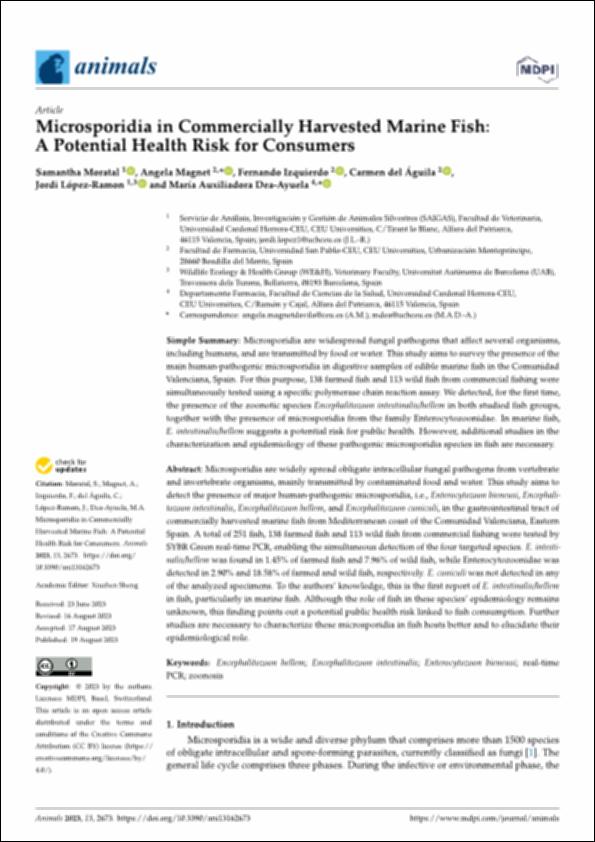Por favor, use este identificador para citar o enlazar este ítem:
http://hdl.handle.net/10637/15106Microsporidia in Commercially Harvested Marine Fish: A Potential Health Risk for Consumers
| Título : | Microsporidia in Commercially Harvested Marine Fish: A Potential Health Risk for Consumers |
| Autor : | Moratal, Samantha Magnet, Angela Izquierdo Arias, Fernando Águila de la Puente, Carmen del López Ramon, Jordi Dea Ayuela, María Auxiliadora |
| Materias: | Encephalitozoon hellem; Encephalitozoon intestinalis; Enterocytozoon bieneusi; Real-time; PCR; Zoonosis |
| Editorial : | MDPI |
| Citación : | Moratal S, Magnet A, Izquierdo F, Del Águila C, López-Ramon J, Dea-Ayuela MA. Microsporidia in Commercially Harvested Marine Fish: A Potential Health Risk for Consumers. Animals (Basel). 2023 Aug 19;13(16):2673. doi: 10.3390/ani13162673. PMID: 37627464; PMCID: PMC10451485 |
| Resumen : | Microsporidia are widely spread obligate intracellular fungal pathogens from vertebrate and invertebrate organisms, mainly transmitted by contaminated food and water. This study aims to detect the presence of major human-pathogenic microsporidia, i.e., Enterocytozoon bieneusi, Encephalitozoon intestinalis, Encephalitozoon hellem, and Encephalitozoon cuniculi, in the gastrointestinal tract of commercially harvested marine fish from Mediterranean coast of the Comunidad Valenciana, Eastern Spain. A total of 251 fish, 138 farmed fish and 113 wild fish from commercial fishing were tested by SYBR Green real-time PCR, enabling the simultaneous detection of the four targeted species. E. intestinalis/ hellem was found in 1.45% of farmed fish and 7.96% of wild fish, while Enterocytozoonidae was detected in 2.90% and 18.58% of farmed and wild fish, respectively. E. cuniculi was not detected in any of the analyzed specimens. To the authors’ knowledge, this is the first report of E. intestinalis/hellem in fish, particularly in marine fish. Although the role of fish in these species’ epidemiology remains unknown, this finding points out a potential public health risk linked to fish consumption. Further studies are necessary to characterize these microsporidia in fish hosts better and to elucidate their epidemiological role. |
| URI : | http://hdl.handle.net/10637/15106 |
| Derechos: | http://creativecommons.org/licenses/by-nc-nd/4.0/deed.es OpenAccess |
| ISSN : | 2076-2615 |
| Fecha de publicación : | 19-ago-2023 |
| Centro : | Universidad San Pablo-CEU |
| Aparece en las colecciones: | Facultad de Farmacia |
Los ítems de DSpace están protegidos por copyright, con todos los derechos reservados, a menos que se indique lo contrario.


